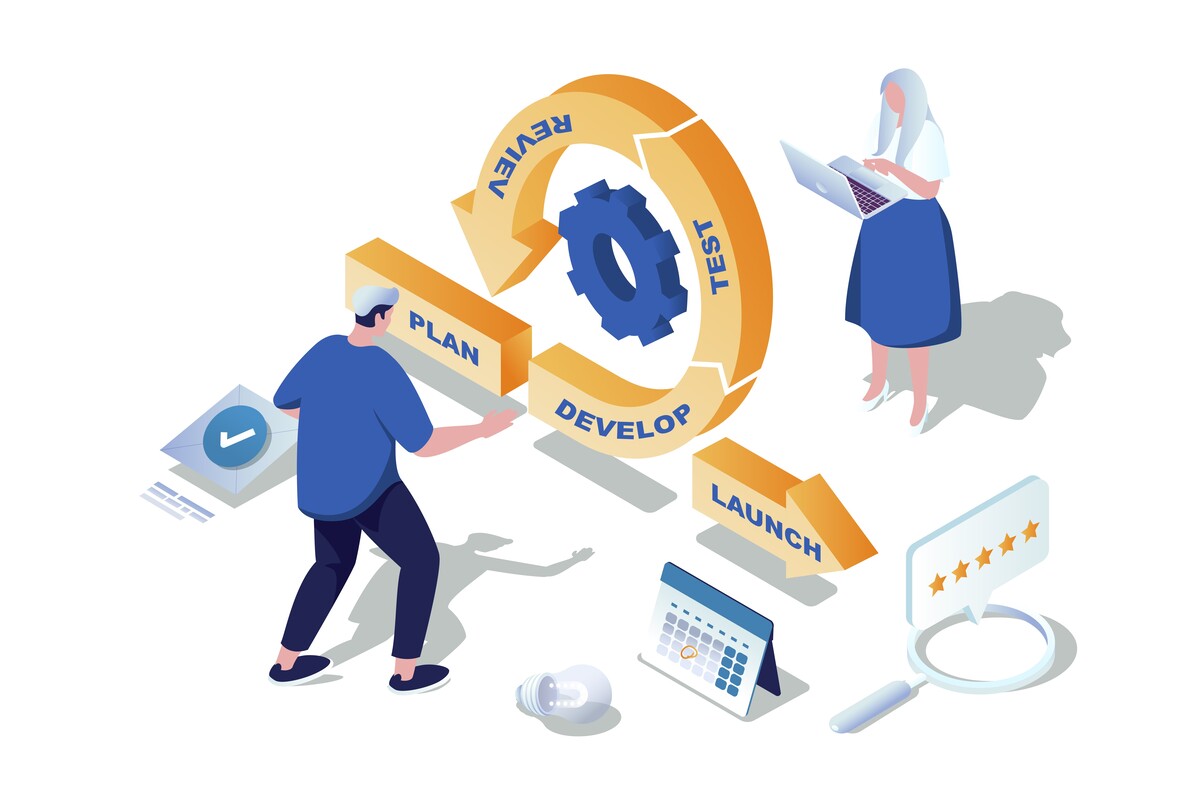Iterative and incremental software development is the foundation of agile development. It strongly emphasizes the continuous delivery of functional software, communication between developers and stakeholders, and user feedback to ensure that requirements are met.
Agile development is based on four essential tenets:
- Persons and interactions, rather than procedures and tools
- Functional software above thorough documentation
- Customer involvement during contract negotiations
- Adapting to change versus sticking to a plan
Persons and interactions, rather than procedures and tools
Agile development prioritizes people and relationships over procedures and equipment. Effective communication and a positive working relationship between developers and stakeholders are more crucial than following a rigid methodology.
Functional software above thorough documentation
Working software above in-depth documentation is another essential agile development tenet. A working product that can be tested and utilized might be more important than thorough documentation.
Customer involvement during contract negotiations
In agile development, customer collaboration is also more crucial than contract negotiation. It is because having a comprehensive contract in place is less important than getting client feedback and ensuring their needs are satisfied.
Adapting to change versus sticking to a plan
Last but not least, agile development prioritizes adapting to change over sticking to a plan. Flexibility in response to change is more crucial than strict adherence to a project.
Fundamental Principles of Agile Development
The Agile methodology has wholly revolutionized the software development industry in recent years.
There are various causes for this, but the capacity to adapt to change and the emphasis on teamwork are two of the most important advantages.
Projects can be reasonably rigid when using the classic waterfall methodology because they are frequently predetermined. If the requirements alter or the project scope needs to be adjusted, this could cause issues later.
Teams are better able to adjust to change when they use Agile. This results from the process’s emphasis on quick, iterative sprints. If the needs change, making the required modifications in the subsequent sprint is more straightforward.
The emphasis on collaboration in Agile is yet another key benefit. There may be several silos between various teams when using the classic waterfall process. But in Agile, everyone collaborates to achieve a common objective. It promotes improved communication and assists in removing barriers between teams.
The advantages of the Agile methodology are extensive overall. Agile may be the best option if you’re searching for a more adaptable and team-based software development method.
Benefits of Agile Methodologies in Software Development
The phrase “DevOps” is a combination of the words “development” and “operations.” It refers to procedures that stress the cooperation and communication of software developers and information technology (IT) experts while automating software delivery and infrastructure improvements. DevOps aims to deliver features, repairs, and updates more quickly and consistently.
DevOps has several advantages. However, the following are the most crucial ones:
Faster time to market: DevOps teams can deploy new features, patches, and upgrades faster by automating the software delivery process.
Quality improvement: Automating the software delivery process can also raise software quality. DevOps teams may quickly find and address quality issues by automating testing and employing automated monitoring technologies.
Increased agility: DevOps teams can react to market, or customer needs changes fast. They may rapidly and easily modify the program by automating the software delivery process.
Customer satisfaction is increased because DevOps teams can provide features, fixes, and customer upgrades more quickly. As a result, consumer loyalty and satisfaction may increase.
DevOps is not new, but it has become more well-known recently as businesses have begun to use agile approaches. DevOps is frequently used with agile methodology, but it is unnecessary. DevOps may be applied there whether a company uses agile methods or not.
Although there are numerous tools and technologies used in DevOps, some of the most well-liked ones include:
Automation: A crucial component of DevOps is automation. DevOps teams are better able to provide new features, patches, and upgrades more quickly by automating the software delivery process.
Continuous integration (CI) frequently integrates every developer’s working copy with the shared mainline. DevOps teams may swiftly identify and correct mistakes by doing this.
Continuous delivery (CD) is the process of distributing updates to software often. Thanks to CD, DevOps teams can deploy new features, fixes, and upgrades more quickly and consistently.
Exploring DevOps and its Importance in the Software Development Lifecycle
There are only so many software development solutions that will instantly make all of your procedures more productive. Nevertheless, much evidence supports the idea that some pairings of approaches and technologies might work in concert to create something more significant than the sum of its parts. In this post, we’ll examine how agile techniques and DevOps complement one another and how you can utilize them to enhance your software development process.
Iterative development, which adds new features incrementally, is the foundation of agile techniques. This method differs from the conventional waterfall model in which all components are created simultaneously and released simultaneously. Agile has the benefit of allowing for quicker feedback and greater flexibility. The drawback is that it may be challenging to anticipate when a specific feature will be ready for release.
The DevOps set of practices aims to automate the software development cycle. It covers techniques like Infrastructure as Code, Continuous Integration, and Continuous Delivery. With the ability to speed up the agile process by automating some of the operations that would otherwise be done manually, DevOps is frequently used in conjunction with agile methodology.
The similarities between agile and DevOps stem from their shared emphasis on speed and adaptability. These two methods can be combined to produce a quicker and more adaptable software development process than either method working alone.
The field of continuous integration is one instance of how this synergy may be applied. Automatically creating and testing new code modifications is known as continuous integration. It can take some time, but it’s necessary to ensure that further code modifications don’t damage any existing functionality.
Developers would write code in a conventional software development process, then pass it to a different team for building and testing. Delays may result because the build team must examine the code before it can be tested.
The build and test process is automated in a DevOps setting. As soon as a modification is committed to the code repository, it may be immediately built and tested. It can save a ton of money.

The Synergy Between Agile Methodologies and DevOps
Five excellent practices for integrating agile and DevOps are as follows:
-
Establish a Continuous Delivery Pipeline.
Creating a continuous delivery pipeline is the first best practice for integrating Agile and DevOps. It will make it possible to provide software updates continuously, which is essential for the success of Agile and DevOps. The continuous delivery pipeline must provide automated deployments, testing, and rollbacks in case of mistakes.
-
Implement trunk-based development
Another effective practice for integrating agile and DevOps is trunk-based development. All code modifications are done to the trunk, the primary development branch, and subsequently, they are released to the live environment. Unlike other development methods like feature branching, where code modifications are done to different departments before being merged into the main branch, this method does not require branching. Trunk-based development enables more frequent and more manageable deployments, which are crucial for the success of Agile and DevOps.
-
A Microservices Architecture should be used.
Another excellent practice for integrating agile and DevOps is a microservices architecture. Each software element is a separate service that can be deployed and scaled separately in a microservices architecture. In contrast, a monolithic design requires all components to be deployed and scaled concurrently and tightly connected throughout. Agile and DevOps can use microservices’ enhanced scalability, mobility, and fault tolerance.
-
Implement containerization
Another effective practice for integrating agile and DevOps is containerization. Applications are bundled into self-contained units called containers that may be deployed and run independently. Containerization is a type of virtualization. In contrast, traditional virtualization contains a full copy of the operating system in each virtual machine, which can be relatively resource-intensive. Containerization enables enhanced portability and resource utilization, which are crucial for the success of Agile and DevOps.
-
Apply best practices for DevOps
Adopting DevOps best practices is the ultimate best practice for integrating Agile and DevOps. The goal of DevOps is to automate and enhance software development.
Implementing Agile and DevOps Integration: Best Practices
The use of the Agile technique to speed up the software development process has grown in popularity in recent years. Agile has the advantage of being simple to combine with DevOps. This blog post will examine six Agile project management solutions that might facilitate a seamless DevOps integration.
-
Jira
A well-liked project management program called Jira may be applied to Agile and DevOps projects. It can track code changes, keep track of builds, and deploy apps, among other characteristics that make it a good fit for DevOps integration.
-
Confluence
Another Atlassian application that can be used for Agile project management is Confluence. It is a collaborative tool that you may use to produce and distribute project-related documents, diagrams, and other information. Additionally, it provides a variety of capabilities that make DevOps integration simple, like the capacity to manage code modifications and keep track of builds.
-
HipChat
HipChat is a chat program that you may use for team collaboration and communication. It includes a lot of capabilities that make it perfect for DevOps integration, like the capacity to establish chat rooms specifically for each project, interface with different applications like Jira and Confluence, and get notifications about code changes and builds.
-
Bamboo
Atlassian offers Bamboo as a tool for continuous integration and delivery. You can use it to automate the process of building, testing, and releasing your software applications. Its features make it perfect for DevOps integration, including the ability to interact with other Atlassian tools, support for various programming languages, and the capacity to use multiple sources to start builds and deploys.
-
Bitbucket
Bitbucket is an Atlassian platform for hosting and collaborating on code. It can organize and track code changes and store and share code. Additionally, it offers several features that simplify DevOps integration, including support for integration with other Atlassian applications.
Agile Project Management Tools for Seamless Integration with DevOps
In Agile, continuous integration (CI) and continuous delivery (CD) are fundamental principles. Even though they are frequently used interchangeably, some significant distinctions exist. In this blog post, we’ll look more closely at CI and CD to see what they are, how they differ, and how you might combine them to speed up your Agile development process.
Continuous Integration: What Is It?
The process of numerous times a day merging all developer working copies with a shared mainline is known as continuous integration. Extreme Programming (XP) promoted this technique at first, and it has subsequently gained widespread acceptance in the agile community.
By often integrating, CI aims to lower the risk of integrating code changes. Developers can rapidly find and resolve integration issues by integrating frequently and early. It is crucial in Agile development, where tracking and fixing integration problems can be challenging due to the quick speed of change.
How does continuous delivery work?
Automating software modifications’ development, testing, and deployment is known as continuous delivery. CD’s main objective is to make software modifications safe and straightforward to deploy anytime.
The principles of CI are expanded upon by CD, which goes one step further by automating the deployment of code changes. It implies that production environments can automatically apply code updates without human intervention.
It enables a more simplified and automated approach to software delivery, so CD is frequently used in conjunction with DevOps.
How Are CI and CD Distinct?
The primary distinction between CI and CD is that while CI concentrates on integrating code changes, CD focuses on automating the deployment of those changes.
The process of merging code changes is the main focus of CI. It entails writing the code, executing the tests, and integrating the code modifications into a shared mainline.
CD goes a step further by automating the actual deployment of code updates. It implies that production environments can automatically apply code updates without human intervention.
How Are CI and CD Integrated?
Combining CI with CD is possible.
Continuous Integration and Continuous Delivery (CI/CD) in Agile DevOps
A set of values and guidelines for software development stated in the Agile Manifesto is called “agile” in this context. A group of software developers dissatisfied with the conventional waterfall approach to software development wrote the manifesto in 2001.
The waterfall method is a sequential, linear approach to software development, where each stage must be finished before moving on to the next. As improvements are challenging to execute after the software is in the later stages of development, this frequently results in delays and frustration.
Agile software development is a more adaptable, iterative process in which needs and solutions are developed through cooperation amongst self-organizing, cross-functional teams. Agile teams produce usable software progressively by working in brief cycles or iterations. It makes it possible to receive feedback and make course changes more frequently, which results in a better-finished product.
These are the eight agile tenets:
- Persons and interactions, rather than procedures and tools
- Functional software above thorough documentation
- Customer involvement during contract negotiations
- Adapting to change versus sticking to a plan
- gradual and iterative development
- progressive delivery
- regular feedback
- ongoing development
These guidelines are meant to serve as a road map for agile teams as they seek to produce quality products.
DevOps 2.0 is the name given to the method that results from integrating Agile and DevOps. Using DevOps 2.0 methods and tools, businesses may produce software faster, with fewer mistakes, and of higher quality overall.
Organizations can enhance their software development process in several ways by integrating Agile and DevOps, including:
- Improved cooperation and communication between the operations and development teams
- Quicker feature delivery and shorter development cycles
- More frequent course modifications and feedback
- Increased software release quality and reliability
Since DevOps 2.0 is still a relatively new idea, there are only so many best ways to execute it. However, a few crucial procedures might assist businesses in beginning the journey toward DevOps 2.0.
Some examples of these practices are:
- CID (continuous integration and delivery)
Agile Testing Strategies in a DevOps Environment
Iterative development, which adds new features incrementally, is the foundation of agile techniques. This method differs from the conventional waterfall model in which all parts are created simultaneously and released simultaneously. Agile has the benefit of allowing for quicker feedback and greater flexibility. The drawback is that it may be challenging to anticipate when a specific feature will be ready for release.
The DevOps set of practices aims to automate the software development cycle. It covers techniques like Infrastructure as Code, Continuous Integration, and Continuous Delivery. With the ability to speed up the agile process by automating some of the operations that would otherwise be done manually, DevOps is frequently used in conjunction with agile methodology.
The similarities between agile and DevOps stem from their shared emphasis on speed and adaptability. These two methods can be combined to produce a quicker and more adaptable software development process than either method working alone.
The field of continuous integration is one instance of how this synergy may be applied. Automatically creating and testing new code modifications is known as continuous integration. It can take some time, but it’s necessary to ensure that further code modifications don’t damage existing functionality.



